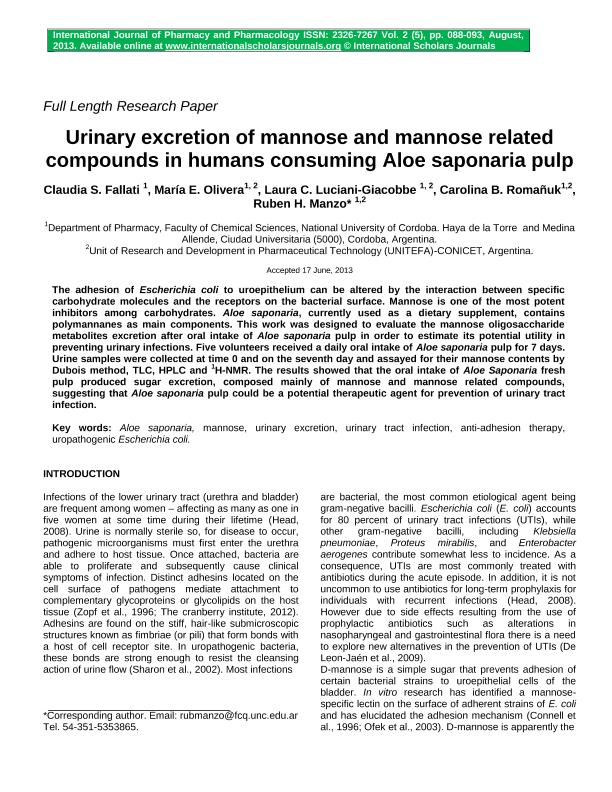Artículo
Urinary excretion of mannose and mannose related compounds in humans consuming Aloe saponaria pulp
Fallati, Claudia Silvina; Olivera, Maria Eugenia ; Luciani Giacobbe, Laura Carolina
; Luciani Giacobbe, Laura Carolina ; Romañuk, Carolina Beatriz; Manzo, Ruben Hilario
; Romañuk, Carolina Beatriz; Manzo, Ruben Hilario
 ; Luciani Giacobbe, Laura Carolina
; Luciani Giacobbe, Laura Carolina ; Romañuk, Carolina Beatriz; Manzo, Ruben Hilario
; Romañuk, Carolina Beatriz; Manzo, Ruben Hilario
Fecha de publicación:
08/2013
Editorial:
International Scholars Journals
Revista:
International Journal of Pharmacy and Pharmacology
ISSN:
2326-7267
Idioma:
Inglés
Tipo de recurso:
Artículo publicado
Clasificación temática:
Resumen
The adhesion of Escherichia coli to uroepithelium can be altered by the interaction between specific carbohydrate molecules and the receptors on the bacterial surface. Mannose is one of the most potent inhibitors among carbohydrates. Aloe saponaria, currently used as a dietary supplement, contains polymannanes as main components. This work was designed to evaluate the mannose oligosaccharide metabolites excretion after oral intake of Aloe saponaria pulp in order to estimate its potential utility in preventing urinary infections. Five volunteers received a daily oral intake of Aloe saponaria pulp for 7 days. Urine samples were collected at time 0 and on the seventh day and assayed for their mannose contents by Dubois method, TLC, HPLC and 1H-NMR. The results showed that the oral intake of Aloe Saponaria fresh pulp produced sugar excretion, composed mainly of mannose and mannose related compounds, suggesting that Aloe saponaria pulp could be a potential therapeutic agent for prevention of urinary tract infection.
Archivos asociados
Licencia
Identificadores
Colecciones
Articulos(CCT - CORDOBA)
Articulos de CTRO.CIENTIFICO TECNOL.CONICET - CORDOBA
Articulos de CTRO.CIENTIFICO TECNOL.CONICET - CORDOBA
Citación
Fallati, Claudia Silvina; Olivera, Maria Eugenia; Luciani Giacobbe, Laura Carolina; Romañuk, Carolina Beatriz; Manzo, Ruben Hilario; Urinary excretion of mannose and mannose related compounds in humans consuming Aloe saponaria pulp; International Scholars Journals; International Journal of Pharmacy and Pharmacology; 2; 5; 8-2013; 88-93
Compartir



